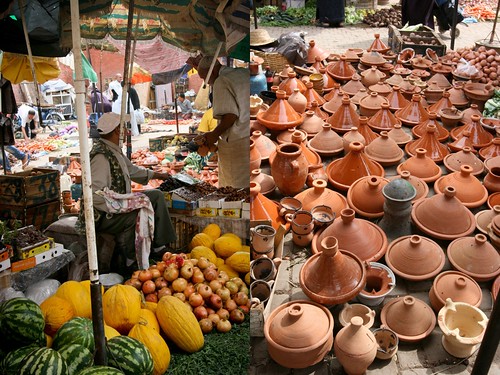My mom and I recently took a trip to Marrakech. It was our first time in Morocco and one of the things we looked forward to the most was the food. We both thought we knew what Moroccan food was like, but in retrospect, we hadn’t a clue beyond couscous and vegetable tagine. However, we quickly learned…
Our education began at our riad, Riad Tizwa, in Marrakech’s Old City. A riad is a large traditional house built around a central courtyard; in Marrakech many of these riads operate as guest houses and provide a much more intimate experience of the city than a traditional hotel. Ours was hidden amongst the maze of the Medina’s winding passages and we wouldn’t have found it were it not for our taxi driver (word to the wise traveller: if your hotel or riad offers airport transport, take them up on it). But behind an unmarked door was a beautiful palatial home scented with local perfume and full of light, greenery, fruit trees and flowers.
Our host greeted us with Moroccan mint tea (which I only knew about thanks to Urvashi Roe’s excellent write-up on the Art of Moroccan Mint Tea) and some sound advice on where we should go for great Moroccan food. As a result, we had some amazing, epic meals – most notably at Ksar Essaoussan and Le Tobsil – that were real lessons in how to feast Moroccan style.
To our collective vegetarian delight, meals started with a selection of cooked and raw salads, but not salads as I’m used too. These were more like little tasting plates of vegetables in various chopped, grated or pureed form. As a result, you didn’t quite know what you were eating until you tried it, making each dish an exciting surprise. Memorable salads include a celery and tomato diced salad with herbs which reminded us of tabbouleh without bulgar. We also had some amazing cooked peppers and tomato seasoned with paprika, cumin and garlic. Spices. Spices were used across the dishes in all kinds of crazy unexpected ways (tomato and cinnamon, for example, and it works).
Main courses were less of a surprise, but I think this is largely due to the vegetarian thing. Everywhere we went we got couscous and vegetable tagine, all delicious and wonderful, but with surprisingly very little variation. Carrots and parsnip was par for the tagine course, with the occasional cauliflower or green pepper. Only once did we get chickpeas in our tagine. We kept talking about how good the tagines were, but how much we wished they had more of this or that, particularly cauliflower (my mother and I both are cauliflower fiends). But a glance at the city’s food markets made it pretty clear that these people were working with a pretty limited selection of ingredients, purely dictated by what was in season at the time. But isn’t that the way it should be?
In a way, this makes the tagine the ultimate seasonal stew, and one of the first things I did when I came home from Marrakech was to make a tagine.
In case you’re unaware, a tagine is a fragrant spicy stew named after the earthenware pot in which it is made (a normal pot, preferably cast iron, also works). With Marrakech in mind, I made my tagine using what was in season, but this time I was working with British ingredients: carrots, romanesco cauliflower and the last of the season’s courgettes and green beans. But this dish would work with almost anything and seems particularly adept to autumn and winter vegetables like swede, butternut squash, pumpkin, potato and cauliflower. I like to keep the vegetables in large chunks and serve it with sprinkled with toasted almonds. It’s the perfect thing on a cold, wet, dreary British day. And oddly, it also happens to be the perfect thing on a sweltering hot and sunny afternoon in Morocco: further proof that the tagine is one of the most miraculous dishes around, globe-spanning and eternally versatile.
- 3 tbsp olive oil
- 1 large onion, roughly chopped
- 3 cloves garlic, minced
- 1 inch fresh ginger, minced (or 1 tsp grounded)
- 1-2 tbsp grounded cinnamon
- 1 tsp cumin
- salt
- 1-3 tsp harissa (start with 1tsp and adjust to suit your spice tolerance)
- 2 cups canned chopped tomatoes
- 1 lemon, juice and zest
- a handful fresh cilantro
- 1 small pumpkin or butternut squash, peeled and cut into 2-inch pieces
- 3 carrots, peeled and cut into 2-inch pieces
- 1 small cauliflower, broken into big florets
- 1/2 cup cooked chickpeas
- a handful of raisins
- toasted sliced almonds
- couscous to serve
- Heat olive oil in a large pot and sauté the onion for a few minutes until it softens.
- Add garlic, ginger and the spices and stir around a bit.
- Add the harissa, tomatoes, lemon juice and fresh cilantro. Bring the tomato sauce to a boil and then lower the heat.
- Add the vegetables and stir around, make sure that all vegetables are somewhat covered in tomato sauce. Put the lid on and simmer for about an hour. Stir carefully once or twice, otherwise leave the lid on – and be patient!
- Serve with couscous and a sprinkle of toasted sliced almonds.
This recipe also appeared on Great British Chefs.








It stinks that you didn’t get more variety with the tagines, but absolutely lovely that it was that way for seasonality! (And, yes, more cauliflower is often the answer–yum.)
Love your tagine recipe; definitely going to have to try it out this winter!
Adding this to my “to make” list. I still have fond memories of the food in Morocco!
I love moroccan food. This tagine looks delish!